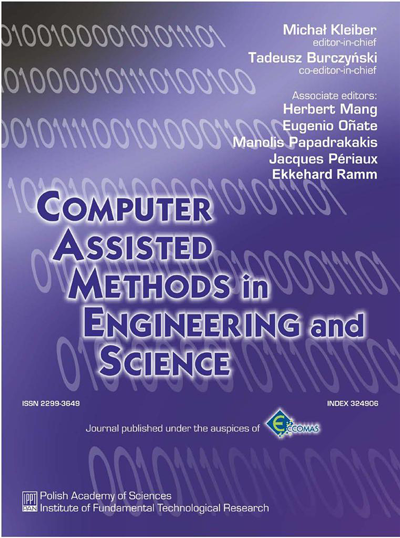Homogenization of sandwich panels
Abstract
The numerical modeling of plates with periodic corrugation requires some efforts to be made in terms of careful and precise discretization of the complicated structure. This automatically generates very computationally expensive models. One of the most popular methods of model simplification is analytical or numerical homogenization. The main goal of this paper is to present the homogenization techniques that can be used to effectively model sandwich panels such as corrugated plates in an elastic phase. Two methods of different complexity are described: homogenization through application of the classical laminated plate theory and homogenization through the deformation energy-equivalence method. The accuracy of these methods is compared with the literature data and the results of a structural sample in two basic tests, i.e., the four-point bending test and the uniaxial tensile test. The results show that each method provides similar effective parameters which proves the robustness of the presented methods.
Keywords
homogenization, finite element method, corrugated cardboard,References
[1] Abaqus Analysis User’s Manual: Abaqus 6.11. 28.6.4 Shell section behaviour.[2] Z. Aboura, N. Talbi, S. Allaoui, M.L. Benzeggagh. Elastic behaviour of corrugated cardboard: experiments and modeling. Composite Structures, 63: 53–62, 2004.
[3] S. Allaoui, Z. Aboura, M.L. Benzeggagh. Contribution to the modelling of the corrugated cardboard behaviour.
[4] M.E. Biancolini. Evaluation of equivalent stiffness properties of corrugated board. Composite Structures, 69: 322–328, 2005.
[5] N. Buannic, P. Cartraud, T. Quesnel. Homogenization of corrugated core sandwich panels. Composite Structures, 59: 299–312, 2003.
[6] Y. Cai, L. Xu, G. Cheng. Novel numerical implementation of asymptotic homogenization method for periodic plate structures. International Journal of Solids and Structures, 51(1): 284–292, 2014.
[7] P.W Chung, K.K. Tamma, R.R. Namburu. Asymptotic expansion homogenization for heterogeneous media: computational issues and applications. Composites: Part A, 32: 1291–1301, 2001.
[8] T. Garbowski, M. Jarmuszczak. Homogenization of corrugated paperboard. Part 1. Analytical homogenization [in Polish: Homogenizacja tektury falistej. Część 1. Homogenizacja analityczna]. Przegląd Papierniczy, 70(6): 345–349, 2014.
[9] T. Garbowski, M. Jarmuszczak. Homogenization of corrugated paperboard. Part 2. Numerical homogenization [in Polish: Homogenizacja tektury falistej. Część 2. Homogenizacja numeryczna]. Przegląd Papierniczy, 70(7): 390–394, 2014.
[10] T. Garbowski, M. Jarmuszczak. Numerical strength estimate of corrugated board packages. Part 1. Theoretical assumptions in numerical modeling of paperboard packages [in Polish: Numeryczne wyznaczanie wytrzymałości opakowań z tektury falistej. Cz. 1. Założenia teoretyczne w modelowaniu numerycznym opakowań papierowych]. Przegląd Papierniczy, 70(4): 219–222, 2014.
[11] T. Garbowski, M. Jarmuszczak. Numerical strength estimate of corrugated board packages. Part 2. Experimental tests and numerical analysis of paperboard packages [in Polish: Numeryczne wyznaczanie wytrzymałości opakowań z tektury falistej. Cz. 2. Badania eksperymentalne i analizy numeryczne opakowań papierowych]. Przegląd Papierniczy, 70(5): 277–281, 2014.
[12] H. Hu, S. Belouettar, M. Potier-Ferry, E.M. Daya, A. Makradi. Multi-scale nonlinear modelling of sandwich structures using the Arlequin method. Composite Structures, 2010.
[13] T. Lewinski, J.J. Telega. Plates, laminates and shells. Asymptotic analysis and homogenization. World Scientific, 2000.
[14] A. Marek. Homogenization techniques and constitutive modeling of sandwich panels. Master’s thesis, Poznań University of Technology, 2014.
[15] J.C. Michel, H. Moulinec, P. Suquet. Effective properties of composite materials with periodic microstructure: a computational approach. Comput. Methods Appl. Mech. Engrg., (172): 109–143, 1999.
[16] C. Miehe, A. Koch. Computational micro-to-macro transitions of discretized microstructures undergoing small strains. Archive of Applied Mechanics, 72: 300–317, 2002.
[17] H. Qiao, Q.D. Yang, W.Q. Chen, C.Z. Zhang. Implementation of the Arlequin method into ABAQUS: basic formulation and applications. Advances in Engineering Software, 42: 197–207, 2011.
[18] J.N. Reddy. Mechanics of laminate composite plates and shells. Theory and analysis. CRC Press, 2004.
[19] N. Talbi, A. Batti, R. Ayad, Y.Q. Guo. An analytical homogenization model for finite element modelling of corrugated cardboard. Composite Structures, 88: 280–289, 2009.
[20] A. Urbański. The unified finite element formulation of homogenization of structural members with a periodic microstructure. Wydawnictwo Politechniki Krakowskiej im. Taduesza Kościuszki, 2005.
[21] E. Ventsel, Th. Krauthammer. Thin plates and shells. Theory, analysis, and applications. Marcel Dekker, Inc., 2001.
[22] http://www.fematproject.com/




